Natural Fiber Composites Market: Key Trends Driving Growth in 2024

The natural fiber composites (NFC) market is experiencing significant growth as industries shift toward sustainable and lightweight materials. With increasing environmental concerns, advancements in bio-based materials, and rising demand from automotive, construction, and consumer goods sectors, NFCs are becoming a preferred alternative to traditional composites. In 2024, several key trends are shaping the growth of this dynamic market.
According to Stratview Research, the natural fiber composites market is likely to grow at a healthy CAGR of 5.0% during 2023-2028 to reach USD 0.7 billion valuation in 2028.
1. Rising Demand for Sustainable Materials
As companies across industries strive to reduce carbon footprints, the demand for eco-friendly and biodegradable materials is growing. Natural fiber composites, made from flax, hemp, jute, and kenaf fibers, offer an excellent alternative to synthetic materials like fiberglass. Governments and regulatory bodies worldwide are also promoting bio-based solutions, further accelerating market adoption.
2. Increased Adoption in the Automotive Industry
The automotive sector is a major driver of NFC market growth. Automakers are increasingly using natural fiber composites in interior panels, dashboards, and seatbacks to achieve weight reduction, which improves fuel efficiency and reduces emissions. Leading car manufacturers, including BMW, Mercedes-Benz, and Ford, have already integrated NFCs into vehicle designs, and this trend is expected to continue expanding in 2024.
3. Expansion in Construction and Infrastructure
Natural fiber composites are gaining traction in building and construction due to their high strength-to-weight ratio, moisture resistance, and thermal insulation properties. They are widely used in flooring, wall panels, and roofing applications, providing a durable and sustainable alternative to conventional construction materials. With increasing urbanization and a push for green building materials, the use of NFCs in construction is expected to surge.
4. Advancements in Processing Technologies
Innovations in manufacturing processes such as compression molding, injection molding, and hybrid composite production are improving the mechanical properties and durability of NFCs. These advancements are making natural fiber composites more competitive with synthetic alternatives, enabling their application in high-performance industries like aerospace and sports equipment.
5. Growth in Consumer Goods and Packaging
With a rising focus on biodegradable packaging and sustainable consumer products, NFCs are becoming a preferred choice for furniture, electronics casings, and eco-friendly packaging solutions. As companies seek greener alternatives to plastics, the demand for bio-based composites is expected to grow significantly.
Conclusion
The natural fiber composites market is poised for substantial growth in 2024, driven by sustainability trends, automotive applications, construction demand, and technological advancements. As industries continue to adopt bio-based materials, NFCs are set to revolutionize the composite materials market, offering both environmental and performance benefits.
- Questions and Answers
- Opinion
- Motivational and Inspiring Story
- Technology
- Live and Let live
- Focus
- Geopolitics
- Military-Arms/Equipment
- Security
- Economy
- Beasts of Nations
- Machine Tools-The “Mother Industry”
- Art
- Causes
- Crafts
- Dance
- Drinks
- Film/Movie
- Fitness
- Food
- Games
- Gardening
- Health
- Home
- Literature
- Music
- Networking
- Other
- Party
- Religion
- Shopping
- Sports
- Theater
- Health and Wellness
- News
- Culture

